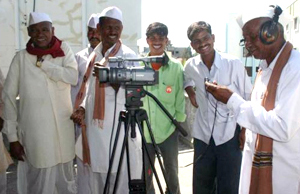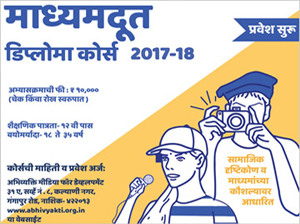
Abhivyakti means expression. Abhivyakti Media for Development is a group of about 19 people oriented towards socialwork. They have used media as a means for education, for motivation in their spheres of activity. The focus of this usage has been on experimenting with media with rural segments of society. Their varied experiences, shared cummulatively have given them insights related to the potential of the media as a contributing and catalytic means to the process of growth. They felt the paucity of relevant material for development oriented work. One of their productions, a video film on the plight of pavement dwellers in Mumbai was well received by the audience. This led to several subsequent happenings and they felt the compelling urge to pool their experience, insights and skills and to start a voluntary organization to cater to the communication and training needs of other organizations working in the field of development.
 The concept that crystallized was to collaborate with other like-minded groups and help them in identifying the media needs and priorities of their areas, based on which the educational media aids, both economic and localized, would be developed. Their background of social work and media experience combined would enable them to produce appropriate media material in tune with the local need.
The concept that crystallized was to collaborate with other like-minded groups and help them in identifying the media needs and priorities of their areas, based on which the educational media aids, both economic and localized, would be developed. Their background of social work and media experience combined would enable them to produce appropriate media material in tune with the local need.
Presently they are based in Nashik, a rural district of Maharashtra. Their address is
Abhivyakti Media for Development
“Omkar” Bungalow,Opposite Wagh Guruji Vidyalaya,
Pumping Station Road, Nashik 422005
Ph – 0253-580981
They have collaborated with rural-based development organizations on the issue of environment in general and forest in particular. This was with a view to fulfill the communication needs of the partner organizations. In this context they have produced two campaigns on forest Rights of the rural and tribal people of Maharashtra. It includes three video films, one slide show and posters on the importance of trees.
 In the course of the above campaign, they have trained animators of these organizations in basic communication skills and tried to make them comfortable with the electronic media. However they found that the animators have a different image of the media-aids, which limits their traditional and dynamic approach in communication with people. Therefore they decided to concentrate on strengthening the resources of the animators in media skills and developing communication concepts.
In the course of the above campaign, they have trained animators of these organizations in basic communication skills and tried to make them comfortable with the electronic media. However they found that the animators have a different image of the media-aids, which limits their traditional and dynamic approach in communication with people. Therefore they decided to concentrate on strengthening the resources of the animators in media skills and developing communication concepts.
Presently they are concentrating on promoting media awareness by way of screening meaningful documentaries, slide-shows, organizing exhibitions of posters and puppet-shows.
To make the role of women more visible and to highlight their tremendous contribution to the society, a 15 – minute slide show has been produced. The presentation of the slide – show comments on the disparity in wage labour and how they have been marginalised with the advent of technology. This show has been screened for rural women and has generated lively debates thus making women reflect upon their low status and drudgery filled life.
This project was initiated in 1991. The aim of the Project is to work with parents of children and to try and promote awareness on issues related to child rearing. A video film on this concept has been produced by them. This film has been screened for various groups of parents through schools or otherwise and it has been well received and helped the movement to take shape. With a view to give a scientific and rational approach to child rearing, creating socially responsible citizens, few workshops on parent education, a daily play centre for children in the age group of 3-12, art and science centre for older children and monthly parents meetings are included as a major part of this movement.
Membership for this project is available at Rs. 100.00 per year and at a concessional rate of Rs. 250.00 for three years.
Recently UNICEF commissioned to them a communication case study to explore the communication flow in a village .. on how information reaches women, how do they interpret it and what kind of impact, if any, does it generate amongst them. The study revealed that the male members of the household were the ones through whom any kind of information reaches the women. Men were the primary channel of communication in the village. Also other women, school going children were instrumental in circulating information amongst the womenfolk.
To achieve this aim a Media Resource Centre has been established. This would operate through the following three modes.
From 1993 they have been regularly visiting two residential schools (Ashram School) for tribal students with the aim of making learning enjoyable for the tribal students and in the process strengthening teacher – student relationship. Simple media material is used for this purpose. The interaction with students has laid the foundation to build a conducive environment for promoting education.
Their resource centre is equipped with books, journals and audio – visual material, which caters to various needs of the local schools, colleges, organizations and individuals. The huge collection of audio-visual films is on the following topics –
Children, communalism, development, education, environment, family, general, health and media .
The library is open for people, with a deposit of Rs. 50.00 and monthly Fees of Rs. 5.00 per month. The video library is also open for people, with a deposit of Rs. 50.00 and Fees of Rs. 5.00 per cassette, per day.
The centre publishes a quarterly magazine in Marathi called “Abhivyakti”, an yearly magazine called “Amhi Palak (We parents)”, a monthly news letter called “Amhi Palak (We parents)” and during summer vacations , they publish in local newspaper “Suttiche Paan” (Holiday special) for children.
Read More – www.abhivyakti.org.in